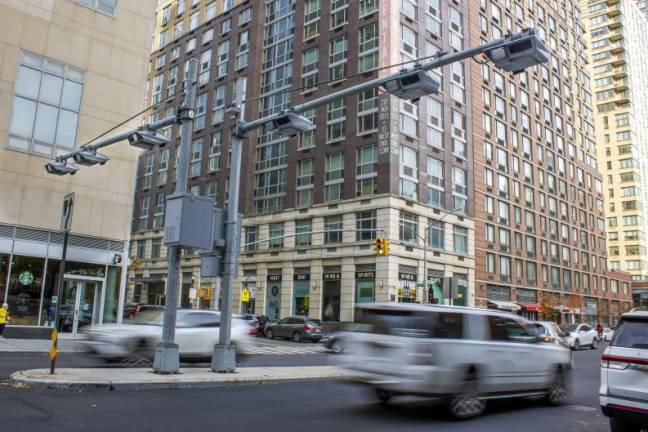Congestion pricing to begin Sunday
REGION. New York governor nixes a surge pricing plan after backlash.

The controversial congestion pricing toll appears to be ready to begin as scheduled Sunday, Jan. 5 after two different federal district court judges on Monday, Dec. 23 refused to issue preliminary injunctions blocking it from taking effect.
But after encountering backlash, Gov. Kathy Hochul is ditching a plan that would have allowed the Metropolitan Transportation Authority (MTA) to hike the $9 toll by 25 percent to $11.25 on days dubbed “gridlock alert” days. There were 20 such days on the calendar in the current year.
Hochul said that “under no circumstances” would she allow the toll to be hiked, even though the MTA, in a little notice part of the plan, retained the right to do so.
The New York Post played up the overlooked clause in the congestion pricing plan with a page-one story on Thursday, Dec. 26, triggering an immediate and furious backlash.
“Kathy Hochul is the Grinch who stole Christmas,” said Rep. Mike Lawler, a Republican from the Hudson Valley region who was re-elected to a second term Nov. 5. He is weighing a run against Hochul for governor in 2026.
Despite the governor switching plans on the surge pricing, the regular congestion pricing is in the fast lane, ready to go live Jan. 5.
Although neither federal judge dismissed the lawsuits in their entirety, the refusal to issue preliminary injunctions all but guaranteed that the new pricing plan will take begin.
Drivers will be charged $9 to enter Manhattan below 60th Street between 6 a.m. and 9 p.m. seven days a week.
Unlike the congestion pricing plan in London that was a model for New York City’s plan, there is no discount for car-owning residents living inside the zone.
The United Federation of Teachers president, Michael Mulgrew; Staten Island borough president Vito Fossella and the Trucking Association of New York sought the injunction from Judge Lewis Liman, but he declined to grant it.
Separately, a different federal court judge in White Plains denied a request from Orange and Rockland counties that also sought to derail the toll with a preliminary injunction.
The judge in that case, Cathy Seibel, rejected the argument from the two suburban counties that the toll represented an unconstitutional tax on commuters from those counties, who often have more limited mass transit options.
“Unfair or unwise is not the same as unconstitutional,” she said in her ruling, noting that the New York state Senate and Assembly had passed the measure, which was signed by Hochul.
MTA officials were ecstatic about their latest victory, which they say will reduce vehicle traffic, ease congestion, cut air pollution and help generate $600 million in toll revenue that will go into mass transit improvements.
“We are gratified by the decisions from these courts,” said John McCarthy, the MTA’s chief of policy. “The cases have highlighted how extensively the Central Business District Tolling Program was studied as well as the enormous benefits it’s expected to provide both to drivers and mass transit users.
“Congestion pricing will finally tackle the gridlock that is slowing down emergency vehicles, polluting air and wasting people’s time in traffic. It will also bring sorely needed improvements to transit for the nearly 90 percent of commuters who rely on buses and trains. It’s time for congestion relief, and we are ready to go.”
Hochul has been said to be eager to start the toll because President-elect Donald Trump is an opponent of the plan.
Political observers think the toll would be harder to halt if the plan is already under way.
Hochul is still pushing for the $9 toll but not the surge pricing portion.
“This will reduce traffic in Manhattan and fund long-overdue investments in public transit while keeping costs lower for New Yorkers who drive into the city,” she said in a statement to the Post.
“We have spoken to the MTA and made it clear: under no circumstances will I allow this discretionary 25 percent surcharge on gridlock days to be used.”
Opponents of the plan vow to continue the fight against the $9 toll.
“Pollution and traffic congestion will be worse in the poor, working- and middle-class neighborhoods of the city, and these same families are still being asked to shoulder the cost,” Mulgrew has said.
“No one disputes that New York needs to invest in public transit. But doing it on the backs of the working people of New York City is wrong, and tone deaf.”
At a rally on Forsyth Street in downtown Manhattan on Dec. 17, Francisco Gonzalez, founder of the Lower East Side Business Alliance, called congestion pricing as “just another tax that’s being put on our people ... (that) will affect us all because our food costs are going to go up.”
City Council member Chris Marte also came out strongly against congestion pricing; he is one of the few local politicians to do so.
At the Dec. 17 anti-congestion pricing rally, Kathryn Freed, a former council member and retired Supreme Court judge, said the toll “will hurt the most marginalized residents of Chinatown and the Lower East Side.”
“It will raise the cost of food, deliveries and services for the people least able to afford them. Similarly, the mom-and-pop stores with the smallest profit margins will be forced out of business, causing the loss of jobs.”